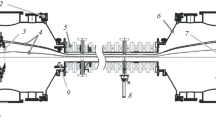Abstract
The basic goal of magnetic confinement is to maintain plasma in an equilibrium state for an extended period using a magnetic field configuration. The plasma equilibrium configuration significantly affects the confinement efficiency and stability of the magnetic confinement device, and we anticipate that the equilibrium discharge of the Trimyx Galatea magnetic trap device will operate in an optimal configuration. The Grad–Shafranov equation, a mathematical model of two-dimensional magneto-fluid static equilibrium of the Trimyx Galatea magnetic trap, was established. Numerical calculations were performed under the conditions of a given magnetic field configuration and plasma pressure distribution and the evolution laws of the distinctive parameters of the equilibrium configuration were determined under different plasma confinement settings. The magnetic specific volume coupling model was further developed to demonstrate the mechanism of the influence of the magnetic trap magnetic field on the plasma confinement efficiency and properties.












Similar content being viewed by others
REFERENCES
A. I. Morozov and V. V. Savel’ev, Phys.—Usp. 41, 1049 (1998).
J. C. Riordan, A. J. Lichtenberg, and M. A. Lieberman, Nucl. Fusion 19, 21 (1979).
J. Li and Y. Wan, Engineering 7, 1523 (2021).
A. I. Morozov, A. I. Bugrova, A. M. Bishaev, A. S. Lipatov, and M. V. Kozintseva, Tech. Phys. 52, 1546 (2007).
K. V. Brushlinskii and N. A. Chmykhova, Math. Models Comput. Simul. 3, 9 (2011).
B. Tao, W. Tong, X. Jin, and Z. Li, IEEE Trans. Plasma Sci. 44, 1779 (2016).
K. V. Brushlinskii and E. V. Stepin, J. Phys.: Conf. Ser. 1686, 012030 (2020).
K. V. Brushlinskii and P. A. Ignatov, Comput. Math. Math. Phys. 50, 2071 (2010).
K. V. Brushlinskii and A. S. Goldich, Plasma Phys. Rep. 40, 591 (2014).
W. Tong, B. Tao, X. Jin, and Z. Li, IEEE Trans. Plasma Sci. 44, 1018 (2016).
A. I. Morozov, A. I. Bugrova, A. M. Bishaev, M. V. Ko-zintseva, A. S. Lipatov, V. I. Vasil’ev, and V. M. Strunnikov, Plasma Phys. Rep. 32, 171 (2006).
K. V. Brushlinskii, A. S. Gol’dich, and A. S. Desyatova, Math. Models Comput. Simul. 5, 156 (2013).
E. E. Ortiz, A. C. Boxer, J. L. Ellsworth, D. T. Garnier, A. Hansen, I. Karim, J. Kesner, and M. E. Manuel, J. Fusion Energy 26, 139 (2007).
W. M. Tong, B. Q. Tao, X. J. Jin, and Z. W. Li, Plasma Phys. Rep. 42, 919 (2016).
K. V. Brushlinskii and E. V. J. Stepin, J. Phys.: Conf. Ser. 2028, 012026 (2021).
A. I. Morozov, A. I. Bugrova, A. M. Bishaev, M. V. Ko-zintseva, and A. S. Lipatov, Tech. Phys. Lett. 32, 33 (2006).
A. M. Bishaev, A. I. Bugrova, M. B. Gavrikov, M. V. Ko-zintseva, A. S. Lipatov, V. V. Savel’ev, A. S. Sigov, P. G. Smirnov, I. A. Tarelkin, and P. P. Khramtsov, Tech. Phys. 58, 498 (2013).
D. Van Eester, E. Lerche, P. Huynh, T. Johnson, D. Yadikin, Ž. Štancar, S. Aleiferis, D. Frigione, L. Garzotti, P. Lomas, C. Lowry, M. Maslov, JET contributors, and EUROfusion-IM team, Plasma Phys. Controlled Fusion 64, 055014 (2022).
K. Miyamoto, Plasma Physics and Controlled Nuclear Fusion (MIT Press, Cambridge, MA, 1979), p. 32.
J. Egedal, H. J. Monkhorst, E. Lichko, and P. Montag, Phys. Plasmas 25, 072510 (2018).
ACKNOWLEDGMENTS
The authors would like to thank G.E. Bugrov from the Plasma Physics and Technology Laboratory of the National Radio, Electronics and Automation University in Moscow (MIREA). The authors would also like to thank for the research funding of the Hubei Superior and Distinctive Discipline Group of “New Energy Vehicles and Smart Transportation” for this project.
Funding
This work was supported by ongoing institutional funding. No additional grants to carry out or direct this particular research were obtained.
Author information
Authors and Affiliations
Corresponding author
Ethics declarations
The authors of this work declare that they have no conflicts of interest.
Additional information
Publisher’s Note.
Pleiades Publishing remains neutral with regard to jurisdictional claims in published maps and institutional affiliations.
Rights and permissions
About this article
Cite this article
Tao, B.Q., Liu, J., Liang, P. et al. Confinement Performance of the Plasma Equilibrium Configuration of Compact Galatea Magnetic Trap. Plasma Phys. Rep. 50, 12–22 (2024). https://doi.org/10.1134/S1063780X23601116
Received:
Revised:
Accepted:
Published:
Issue Date:
DOI: https://doi.org/10.1134/S1063780X23601116



